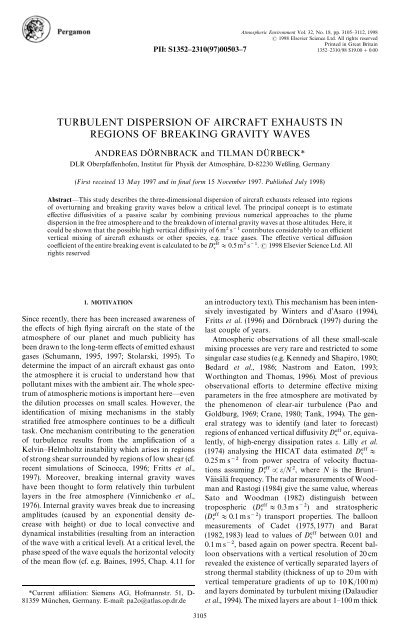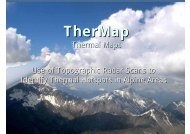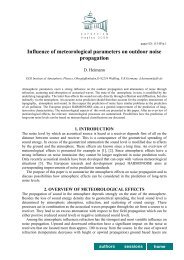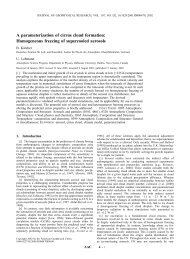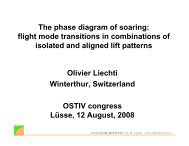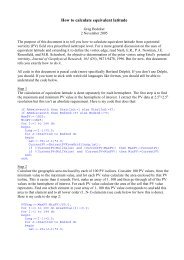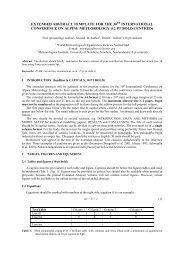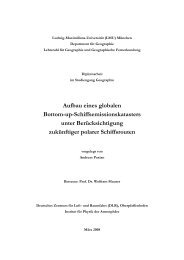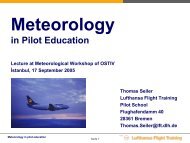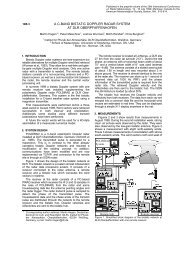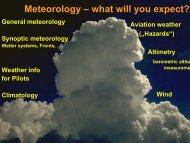turbulent dispersion of aircraft exhausts in regions of breaking ...
turbulent dispersion of aircraft exhausts in regions of breaking ...
turbulent dispersion of aircraft exhausts in regions of breaking ...
Create successful ePaper yourself
Turn your PDF publications into a flip-book with our unique Google optimized e-Paper software.
PII: S1352–2310(97)00503–7<br />
Atmospheric Environment Vol. 32, No. 18, pp. 3105—3112, 1998<br />
1998 Elsevier Science Ltd. All rights reserved<br />
Pr<strong>in</strong>ted <strong>in</strong> Great Brita<strong>in</strong><br />
1352—2310/98 $19.00#0.00<br />
TURBULENT DISPERSION OF AIRCRAFT EXHAUSTS IN<br />
REGIONS OF BREAKING GRAVITY WAVES<br />
ANDREAS DO RNBRACK and TILMAN DU RBECK*<br />
DLR Oberpfaffenh<strong>of</strong>en, Institut für Physik der Atmosphäre, D-82230 We{l<strong>in</strong>g, Germany<br />
(First received 13 May 1997 and <strong>in</strong> f<strong>in</strong>al form 15 November 1997. Published July 1998)<br />
Abstract—This study describes the three-dimensional <strong>dispersion</strong> <strong>of</strong> <strong>aircraft</strong> <strong>exhausts</strong> released <strong>in</strong>to <strong>regions</strong><br />
<strong>of</strong> overturn<strong>in</strong>g and break<strong>in</strong>g gravity waves below a critical level. The pr<strong>in</strong>cipal concept is to estimate<br />
effective diffusivities <strong>of</strong> a passive scalar by comb<strong>in</strong><strong>in</strong>g previous numerical approaches to the plume<br />
<strong>dispersion</strong> <strong>in</strong> the free atmosphere and to the breakdown <strong>of</strong> <strong>in</strong>ternal gravity waves at those altitudes. Here, it<br />
could be shown that the possible high vertical diffusivity <strong>of</strong> 6 m s contributes considerably to an efficient<br />
vertical mix<strong>in</strong>g <strong>of</strong> <strong>aircraft</strong> <strong>exhausts</strong> or other species, e.g. trace gases. The effective vertical diffusion<br />
coefficient <strong>of</strong> the entire break<strong>in</strong>g event is calculated to be D+0.5 m s. 1998 Elsevier Science Ltd. All<br />
rights reserved<br />
<br />
1. MOTIVATION<br />
S<strong>in</strong>ce recently, there has been <strong>in</strong>creased awareness <strong>of</strong><br />
the effects <strong>of</strong> high fly<strong>in</strong>g <strong>aircraft</strong> on the state <strong>of</strong> the<br />
atmosphere <strong>of</strong> our planet and much publicity has<br />
been drawn to the long-term effects <strong>of</strong> emitted exhaust<br />
gases (Schumann, 1995, 1997; Stolarski, 1995). To<br />
determ<strong>in</strong>e the impact <strong>of</strong> an <strong>aircraft</strong> exhaust gas onto<br />
the atmosphere it is crucial to understand how that<br />
pollutant mixes with the ambient air. The whole spectrum<br />
<strong>of</strong> atmospheric motions is important here—even<br />
the dilution processes on small scales. However, the<br />
identification <strong>of</strong> mix<strong>in</strong>g mechanisms <strong>in</strong> the stably<br />
stratified free atmosphere cont<strong>in</strong>ues to be a difficult<br />
task. One mechanism contribut<strong>in</strong>g to the generation<br />
<strong>of</strong> turbulence results from the amplification <strong>of</strong> a<br />
Kelv<strong>in</strong>—Helmholtz <strong>in</strong>stability which arises <strong>in</strong> <strong>regions</strong><br />
<strong>of</strong> strong shear surrounded by <strong>regions</strong> <strong>of</strong> low shear (cf.<br />
recent simulations <strong>of</strong> Sc<strong>in</strong>occa, 1996; Fritts et al.,<br />
1997). Moreover, break<strong>in</strong>g <strong>in</strong>ternal gravity waves<br />
have been thought to form relatively th<strong>in</strong> <strong>turbulent</strong><br />
layers <strong>in</strong> the free atmosphere (V<strong>in</strong>nichenko et al.,<br />
1976). Internal gravity waves break due to <strong>in</strong>creas<strong>in</strong>g<br />
amplitudes (caused by an exponential density decrease<br />
with height) or due to local convective and<br />
dynamical <strong>in</strong>stabilities (result<strong>in</strong>g from an <strong>in</strong>teraction<br />
<strong>of</strong> the wave with a critical level). At a critical level, the<br />
phase speed <strong>of</strong> the wave equals the horizontal velocity<br />
<strong>of</strong> the mean flow (cf. e.g. Ba<strong>in</strong>es, 1995, Chap. 4.11 for<br />
*Current affiliation: Siemens AG, H<strong>of</strong>mannstr. 51, D-<br />
81359 Mu¨ nchen, Germany. E-mail: pa2o@atlas.op.dr.de<br />
an <strong>in</strong>troductory text). This mechanism has been <strong>in</strong>tensively<br />
<strong>in</strong>vestigated by W<strong>in</strong>ters and d’Asaro (1994),<br />
Fritts et al. (1996) and Do¨ rnbrack (1997) dur<strong>in</strong>g the<br />
last couple <strong>of</strong> years.<br />
Atmospheric observations <strong>of</strong> all these small-scale<br />
mix<strong>in</strong>g processes are very rare and restricted to some<br />
s<strong>in</strong>gular case studies (e.g. Kennedy and Shapiro, 1980;<br />
Bedard et al., 1986; Nastrom and Eaton, 1993;<br />
Worth<strong>in</strong>gton and Thomas, 1996). Most <strong>of</strong> previous<br />
observational efforts to determ<strong>in</strong>e effective mix<strong>in</strong>g<br />
parameters <strong>in</strong> the free atmosphere are motivated by<br />
the phenomenon <strong>of</strong> clear-air turbulence (Pao and<br />
Goldburg, 1969; Crane, 1980; Tank, 1994). The general<br />
strategy was to identify (and later to forecast)<br />
<strong>regions</strong> <strong>of</strong> enhanced vertical diffusivity D or, equivalently,<br />
<strong>of</strong> high-energy dissipation rates ε. Lilly et al.<br />
<br />
(1974) analys<strong>in</strong>g the HICAT data estimated D<br />
+<br />
0.25 m s from power spectra <strong>of</strong> velocity fluctuations<br />
assum<strong>in</strong>g DJε/N, where N is the Brunt—<br />
<br />
Väisa¨ lä frequency. The radar measurements <strong>of</strong> Woodman<br />
and Rastogi (1984) give the same value, whereas<br />
Sato and Woodman (1982) dist<strong>in</strong>guish between<br />
tropospheric (D+0.3 m s) and stratospheric<br />
<br />
(D+0.1 m s) transport properties. The balloon<br />
<br />
measurements <strong>of</strong> Cadet (1975, 1977) and Barat<br />
(1982, 1983) lead to values <strong>of</strong> D between 0.01 and<br />
<br />
0.1 m s, based aga<strong>in</strong> on power spectra. Recent balloon<br />
observations with a vertical resolution <strong>of</strong> 20 cm<br />
revealed the existence <strong>of</strong> vertically separated layers <strong>of</strong><br />
strong thermal stability (thickness <strong>of</strong> up to 20 m with<br />
vertical temperature gradients <strong>of</strong> up to 10 K/100 m)<br />
and layers dom<strong>in</strong>ated by <strong>turbulent</strong> mix<strong>in</strong>g (Dalaudier<br />
et al., 1994). The mixed layers are about 1—100 m thick<br />
3105
3106 A. DO RNBRACK and T. DU RBECK<br />
and their occurence is well correlated with the existence<br />
<strong>of</strong> vertically propagat<strong>in</strong>g gravity waves.<br />
Other estimates <strong>of</strong> D are based on numerical<br />
<br />
simulations <strong>of</strong> mix<strong>in</strong>g processes <strong>in</strong> the free atmosphere.<br />
Schill<strong>in</strong>g and Etl<strong>in</strong>g (1996) studied the twodimensional<br />
<strong>dispersion</strong> <strong>of</strong> <strong>aircraft</strong> plumes <strong>in</strong> break<strong>in</strong>g<br />
gravity waves. A Lagrangian particle model allowed<br />
to estimate an effective diffusion coefficient for the<br />
entire break<strong>in</strong>g event <strong>of</strong> about 0.7 m s.Du¨ rbeck and<br />
Gerz (1995, 1996) <strong>in</strong>vestigated homogeneous atmospheric<br />
conditions with and without shear where the<br />
turbulence decays with time. The length scale <strong>of</strong><br />
the <strong>turbulent</strong> eddies was <strong>of</strong> the order <strong>of</strong> the exhaust<br />
plume diameter. In these three-dimensional largeeddy<br />
simulations, typical mean characteristics <strong>of</strong> the<br />
predom<strong>in</strong>antely quiet free atmosphere were prescribed<br />
<strong>in</strong> terms <strong>of</strong> the mean vertical w<strong>in</strong>d shear S and<br />
the Brunt—Väisälä frequency N, lead<strong>in</strong>g to bulk<br />
Richardson numbers rang<strong>in</strong>g from 0.1 to R. The<br />
<strong>dispersion</strong> <strong>of</strong> a large ensemble <strong>of</strong> <strong>aircraft</strong> plumes was<br />
analysed statistically. For Richardson numbers larger<br />
than 1, the effective vertical diffusivity D did not<br />
<br />
exceed values <strong>of</strong> 0.18 m s. The shearless case constituted<br />
the lower limit for D <strong>of</strong> 0.15$0.01 m s.<br />
<br />
Only for the low Richardson number <strong>of</strong> 0.13 the<br />
simulations lead to values for D as high as about<br />
<br />
3ms.<br />
Along flight legs <strong>of</strong> commercial <strong>aircraft</strong>s the ambient<br />
air is usually weakly <strong>turbulent</strong> and turbulence<br />
encounters occur only occasionally. This exceptional<br />
case is considered here. It is supposed that rare but<br />
<strong>in</strong>tense <strong>turbulent</strong> events contribute to an effective<br />
vertical mix<strong>in</strong>g at least as much as the diffusion under<br />
decay<strong>in</strong>g <strong>turbulent</strong> conditions. For this purpose, this<br />
study is concerned with the <strong>dispersion</strong> <strong>of</strong> exhaust<br />
plumes released at cruis<strong>in</strong>g altitudes <strong>in</strong>to <strong>regions</strong> <strong>of</strong><br />
localised generated turbulence. Here, the break<strong>in</strong>g <strong>of</strong><br />
<strong>in</strong>ternal gravity waves below a critical level is<br />
simulated by the same high-resolution numerical<br />
model as presented by Do¨ rnbrack (1997) and completed<br />
by the <strong>in</strong>tegration <strong>of</strong> passive scalars. The parameters<br />
<strong>of</strong> the background flow conditions and <strong>of</strong> the<br />
<strong>aircraft</strong> plumes are taken from Dürbeck and Gerz<br />
(1996). The dom<strong>in</strong>ant vertical and horizontal scales <strong>of</strong><br />
this problem are <strong>of</strong> the order <strong>of</strong> about 100 m to 1 km.<br />
These scales are larger than the diameter <strong>of</strong> wake<br />
vortices directly beh<strong>in</strong>d the <strong>aircraft</strong> (50 m) and much<br />
smaller than meteorological disturbances <strong>of</strong> mesoscale<br />
extent (+2002500 km).<br />
2. SET-UP OF THE NUMERICAL EXPERIMENTS<br />
The numerical experiments described here are<br />
three-dimensional, high-resolution simulations <strong>of</strong> the<br />
<strong>dispersion</strong> <strong>of</strong> two-dimensional <strong>aircraft</strong> plumes released<br />
<strong>in</strong>to a region <strong>of</strong> break<strong>in</strong>g gravity waves. The<br />
three-dimensional break<strong>in</strong>g <strong>of</strong> <strong>in</strong>ternal gravity waves<br />
beneath a critical level is simulated by the same model<br />
as described by Do¨ rnbrack (1997) (cf. Fig. 1): a uniform<br />
shear flow over a wavy wall generates vertically<br />
propagat<strong>in</strong>g gravity waves <strong>in</strong> a stably stratified Bouss<strong>in</strong>esq<br />
fluid. These waves turn over and become unstable<br />
beneath the critical level where a <strong>turbulent</strong> mixed<br />
layer evolves.<br />
The flow is simulated <strong>in</strong> a rectangular box with<br />
coord<strong>in</strong>ates x, y, and z, where y is the flight direction<br />
<strong>of</strong> the airplanes and z the vertical direction. The side<br />
lengths <strong>of</strong> the box are the same as <strong>in</strong> the study <strong>of</strong><br />
Dürbeck and Gerz (1996), i.e. ¸"4¸"4H, where<br />
H"1068 m. The <strong>in</strong>itial velocity and temperature<br />
fields are given by<br />
and<br />
º(z)"SM (z!0.5H),<br />
where SM "῀º H<br />
Θ(z)"ϑ #῀Θ H (z!0.5H), where ῀Θ H "Nϑ (1)<br />
g<br />
where the Brunt—Väisäla¨ frequency is N"0.006 s<br />
and the velocity difference between top and bottom<br />
amounts to ῀º"5.5 m s. These values are taken<br />
from case No. 5 <strong>of</strong> Du¨ rbeck’s and Gerz’s study (1996).<br />
Fig. 1. Schematic sketch <strong>of</strong> the computational doma<strong>in</strong> and the background flow conditions. The amplitude<br />
<strong>of</strong> the surface wave is δ"0.04H, its wavelength is λ"4H, where H"1068 m is the vertical depth <strong>of</strong> the<br />
doma<strong>in</strong>. The length <strong>of</strong> the cross stream direction (identical to the flight direction) is ¸"H. The critical<br />
layer z <br />
is def<strong>in</strong>ed by º"0. The velocity and temperature differences ῀º and ῀Θ across H are chosen <strong>in</strong><br />
such a way that the bulk Richardson number Ri <br />
"(g/ϑ <br />
)῀Θ/H/(῀º/H) is approximately 1.4 at the<br />
beg<strong>in</strong>n<strong>in</strong>g.
Turbulent <strong>dispersion</strong> <strong>of</strong> <strong>aircraft</strong> <strong>exhausts</strong> 3107<br />
The bulk Richardson number Ri <br />
"N/SM is approximately<br />
1.4 at the beg<strong>in</strong>n<strong>in</strong>g <strong>of</strong> the simulation.<br />
Dürbeck and Gerz (1995, 1996) considered the effective<br />
diffusion <strong>of</strong> <strong>aircraft</strong> emissions <strong>in</strong> the stably<br />
stratified free atmosphere under shearless and sheared<br />
conditions. There, homogeneous turbulence is <strong>in</strong>itialized<br />
<strong>in</strong> the whole doma<strong>in</strong> by random fields <strong>of</strong><br />
anisotropic velocity components with prescribed<br />
spectra. The turbulence decays and ceases when time<br />
progresses as long as the mean w<strong>in</strong>d shear is not very<br />
strong. The situation described <strong>in</strong> the present paper is<br />
different: the turbulence is generated locally by convective<br />
and dynamical <strong>in</strong>stabilities caused by overturn<strong>in</strong>g<br />
gravity waves. Therefore, the <strong>in</strong>itial flow field<br />
is slightly disturbed by small random temperature<br />
perturbations, otherwise, the flow would rema<strong>in</strong> two<br />
dimensional for all times.<br />
The amplitude <strong>of</strong> the surface wave is δ"0.04H, its<br />
length λ"4H. The short wavelength limit for <strong>in</strong>ternal<br />
gravity waves is given by 2πº/N, where º is the<br />
horizontal w<strong>in</strong>d speed. Hence, for given N and λ, the<br />
atmospheric w<strong>in</strong>d speed is restricted to values below<br />
5ms. Otherwise, no <strong>in</strong>ternal gravity waves would<br />
exist. Further details <strong>of</strong> the numerics and boundary<br />
conditions <strong>of</strong> the dynamical model can be found <strong>in</strong><br />
Dörnbrack et al. (1995) and Do¨ rnbrack (1997).<br />
Three plumes (α"1, 2, 3) with a Gaussian concentration<br />
distribution on the xz-plane and equally distributed<br />
<strong>in</strong> the flight direction y<br />
c(x, z, t <br />
)<br />
" 1 exp<br />
2πσ σ !1 ¸<br />
2 (x!x ) # (z!z )<br />
σ σ <br />
(2)<br />
are released at different horizontal locations x <br />
"0.4,<br />
0.6, and 0.8λ and below the critical level at z <br />
"0.35H.<br />
In addition to study<strong>in</strong>g the supposed dependence <strong>of</strong><br />
the <strong>dispersion</strong> on the <strong>in</strong>itial plume location, their<br />
temporal evolution is <strong>in</strong>vestigated for five successive<br />
release times t <br />
"16, 22, 28, 32, and 36 t <br />
, where<br />
t <br />
"H/῀º"194 s+3 m<strong>in</strong>. Altogether, the <strong>dispersion</strong><br />
<strong>of</strong> 15 exhaust plumes is simulated. The maximum<br />
<strong>in</strong>tegration time is 60 t <br />
, i.e. about 3 h. All numerical<br />
experiments are carried out us<strong>in</strong>g grids with<br />
2566496 po<strong>in</strong>ts <strong>in</strong> the x, y, and z directions, i.e.<br />
the spatial resolution is (16.7, 16.7, 11.3 m).<br />
The quantities σ <br />
and σ <br />
<strong>in</strong> equation (2) are the<br />
horizontal (<strong>in</strong> x-direction) and the vertical variances<br />
<strong>of</strong> the concentration distribution at t <br />
. The present<br />
simulations <strong>of</strong> the plume <strong>dispersion</strong> starts at the end<br />
<strong>of</strong> the so-called <strong>dispersion</strong> regime (CIAP, 1975). At<br />
this stage <strong>of</strong> plume evolution, the <strong>aircraft</strong> <strong>in</strong>duced<br />
turbulence is ceased (Schumann et al., 1995). By then,<br />
the exhaust gases are mixed over a f<strong>in</strong>ite volume with<br />
the ambient air and the exhaust plumes can be represented<br />
by a l<strong>in</strong>e source accord<strong>in</strong>g to equation (2)<br />
where the <strong>in</strong>itial values σ <br />
"117 m and σ <br />
"83 m<br />
are taken from observations <strong>of</strong> 10 m<strong>in</strong> old contrails by<br />
Schumann et al. (1995).<br />
3. RESULTS<br />
3.1. Flow structure<br />
Before the <strong>dispersion</strong> <strong>of</strong> exhaust plumes will be<br />
discussed, a brief overview <strong>of</strong> the simulated flow<br />
evolution is given. Accord<strong>in</strong>g to Dörnbrack (1997),<br />
the gravity-wave break<strong>in</strong>g process can be divided <strong>in</strong>to<br />
three pr<strong>in</strong>cipal periods. Dur<strong>in</strong>g the first period, stationary<br />
gravity waves with respect to topography are<br />
<strong>in</strong>duced by the flow over the fixed wavy surface.<br />
Above the critical level, no or very small, damped<br />
wavy disturbances are observed. Below the critical<br />
level, the ma<strong>in</strong> effect is the long last<strong>in</strong>g acceleration <strong>of</strong><br />
the mean flow <strong>in</strong> the positive x-direction. This wave<strong>in</strong>duced<br />
acceleration due to the deposit <strong>of</strong> horizontal<br />
momentum is opposite to the direction <strong>of</strong> º(z). The<br />
disturbed mean flow raises heavier fluid over lighter<br />
one directly beneath the critical level, whereas the<br />
mean advection <strong>in</strong> the negative x-direction at lower<br />
altitudes moves lighter fluid under heavier one. Between<br />
these levels, the fluid stagnates and a convectively<br />
unstable region extend<strong>in</strong>g over almost one<br />
wavelength λ and with a thickness <strong>of</strong> about 100 m is<br />
formed. The left column <strong>of</strong> Fig. 2 displays the evolv<strong>in</strong>g<br />
temperature field from the end <strong>of</strong> the first period (a)<br />
towards the second period, where an eruptive convective<br />
<strong>in</strong>stability leads to a first <strong>turbulent</strong> breakdown<br />
after about 100 m<strong>in</strong> simulation time (Figs 2c and d).<br />
It takes about six Brunt—Väisäla¨ periods (¹ " <br />
2π/N+17.5 m<strong>in</strong>) until the <strong>in</strong>stability grows to threedimensional<br />
motions. The develop<strong>in</strong>g mixed layer (cf.<br />
left column <strong>of</strong> Fig. 3) is organized <strong>in</strong> shear-driven<br />
overturn<strong>in</strong>g rolls with axes <strong>in</strong> cross-stream direction<br />
and <strong>in</strong> counterrotat<strong>in</strong>g streamwise vortices (not displayed<br />
here, cf. Do¨ rnbrack, 1997). The streamwise<br />
vortices derive their energy ma<strong>in</strong>ly from buoyancy,<br />
later shear dom<strong>in</strong>ates. The flow <strong>in</strong> the mixed layer is<br />
random and vertical on a wide range <strong>of</strong> scales. The<br />
dom<strong>in</strong>ant horizontal scale <strong>in</strong> the range <strong>of</strong> 800—1200 m<br />
is larger than the vertical scale <strong>of</strong> maximum<br />
250 m. The third and last stage <strong>of</strong> flow evolution<br />
is characterized by a quasi-steady equilibrium<br />
between shear production and mechanical dissipation<br />
<strong>of</strong> <strong>turbulent</strong> k<strong>in</strong>etic energy. The f<strong>in</strong>al th<strong>in</strong><br />
mixed layer consists <strong>of</strong> isolated patches <strong>of</strong> turbulence<br />
embedded <strong>in</strong> a smooth mean flow that lead to the<br />
sporadic occurrence <strong>of</strong> <strong>turbulent</strong> events at fixed locations.<br />
3.2. Plume <strong>dispersion</strong><br />
The first three sets <strong>of</strong> the plumes (left"black,<br />
middle"blue, and right"red) are emitted dur<strong>in</strong>g<br />
the first period <strong>of</strong> flow evolution (at 52, 71, and<br />
90 m<strong>in</strong>), the other two dur<strong>in</strong>g the second period (at<br />
104 and 116 m<strong>in</strong>). Exemplary for the first group, the<br />
right column <strong>of</strong> Fig. 2 displays the plume <strong>dispersion</strong> <strong>of</strong><br />
the second set whereas the sequence <strong>of</strong> concentration<br />
fields <strong>in</strong> Fig. 3 depicts the development for the last<br />
set. Both figures cover the same <strong>in</strong>terval <strong>of</strong> 12 t + <br />
40 m<strong>in</strong>.
3108 A. DO RNBRACK and T. DU RBECK<br />
Fig. 2. Contours plots <strong>of</strong> the y-averaged temperature (left) and concentration fields (right) evolv<strong>in</strong>g <strong>in</strong> time.<br />
The three Gaussian plumes (cf. equation (2)) are emitted <strong>in</strong>stantaneously at t"71 m<strong>in</strong> (a) after model<br />
<strong>in</strong>itialization. The temporal <strong>in</strong>terval between the panel rows (a) to (d) is 13 m<strong>in</strong>. The thickness <strong>of</strong> the black<br />
temperature segments amounts to 0.007῀Θ. Broader (th<strong>in</strong>ner) segments <strong>in</strong>dicates reduced (enhanced)<br />
thermal stability. The contour levels <strong>of</strong> the concentration field are equidistant and are chosen uniformly for<br />
all plots.<br />
Fig. 3. As Fig. 2 for a plume released at t"116 m<strong>in</strong> after model <strong>in</strong>itialization. Aga<strong>in</strong>, the temporal <strong>in</strong>terval<br />
between the panel rows is 13 m<strong>in</strong>.
Turbulent <strong>dispersion</strong> <strong>of</strong> <strong>aircraft</strong> <strong>exhausts</strong> 3109<br />
The most remarkable feature <strong>of</strong> the sequence shown<br />
<strong>in</strong> Fig. 2 is the rapid horizontal spread <strong>of</strong> the lower<br />
portions <strong>of</strong> all three plumes <strong>in</strong>to the downstream<br />
direction while their upper portions rema<strong>in</strong> almost<br />
stationary. The weak deformation and advection <strong>of</strong><br />
the upper parts is a product <strong>of</strong> the nearly zero horizontal<br />
velocity close to the critical level. However,<br />
there is a horizontal drift <strong>of</strong> the red (black) plume<br />
towards right (left) due to the wave-<strong>in</strong>duced acceleration<br />
<strong>of</strong> the mean flow. This additional advection fully<br />
affects the uppermost portion <strong>of</strong> the red plume and<br />
only the lower portions <strong>of</strong> the blue and black ones.<br />
The result<strong>in</strong>g advection which is modified by waves<br />
and dependent on height forms the characteristic<br />
S-shape <strong>of</strong> both plumes (Figs 2b and c). The lower<br />
portions <strong>of</strong> the concentration distributions are controlled<br />
by shear deformation and their structures rem<strong>in</strong>d<br />
<strong>of</strong> f<strong>in</strong>d<strong>in</strong>gs by Du¨ rbeck and Gerz (1996) where<br />
the prescribed uniform shear causes a symmetrical<br />
stretch<strong>in</strong>g <strong>of</strong> isocontours with respect to the centre <strong>of</strong><br />
mass. In the present study, the horizontal spread<br />
depends strongly on the local w<strong>in</strong>d field, i.e. on the<br />
<strong>in</strong>dividual location <strong>of</strong> plume release. The vertical<br />
spread depends on the horizontal release position,<br />
too. In this stage <strong>of</strong> flow evolution, the vertical spread<br />
is not yet affected by three-dimensional <strong>turbulent</strong><br />
motions. The vertical expansion is ma<strong>in</strong>ly produced<br />
by wave-<strong>in</strong>duced vertical motions (upwards/downwards<br />
for flows <strong>in</strong> the luv/lee <strong>of</strong> the crest) that transport<br />
exhaust gases <strong>in</strong>to layers <strong>of</strong> different horizontal<br />
velocity. The height-vs-time plots <strong>of</strong> the locations <strong>of</strong><br />
maximum concentration confirm that the outer<br />
plumes undergo the most vigorous vertical excursions<br />
(Fig. 4a) : the red (black) plume is f<strong>in</strong>ally displaced<br />
upwards (downwards) whereas the slowly dispers<strong>in</strong>g<br />
blue plume rema<strong>in</strong>s essentially at the same height.<br />
The <strong>dispersion</strong> <strong>of</strong> <strong>aircraft</strong> <strong>exhausts</strong> emitted at<br />
t " 116 m<strong>in</strong> (which is six m<strong>in</strong>utes later than the time<br />
at which the fields are shown <strong>in</strong> Fig. 2) reveals the<br />
dom<strong>in</strong>ant <strong>in</strong>fluence <strong>of</strong> the beg<strong>in</strong>n<strong>in</strong>g <strong>turbulent</strong> diffusion,<br />
esp. that <strong>of</strong> the black plume (cf. Fig. 3). Initially,<br />
its <strong>dispersion</strong> evolves similarly as <strong>in</strong> the previous<br />
example. In addition, there occurs a horizontal spread<br />
towards the positive x-direction due to the overturn<strong>in</strong>g<br />
wave <strong>in</strong> this region. It is the <strong>turbulent</strong> breakdown<br />
<strong>of</strong> this wave that mixes and dilutes this plume very<br />
quickly (Figs 3c and d). Likewise, separated portions<br />
<strong>of</strong> the other plumes that are advected <strong>in</strong>to the break<strong>in</strong>g<br />
region get diffused more <strong>in</strong>tense than their almost<br />
stationary parts. Later, smaller scale, shear <strong>in</strong>duced<br />
rolls dilute these rema<strong>in</strong><strong>in</strong>g coherent plume <strong>regions</strong><br />
with ambient air. At the end, the concentration distributions<br />
<strong>of</strong> all plumes are much more diluted compared<br />
to plumes emitted at earlier times. Obviously,<br />
the spread <strong>of</strong> the plumes dom<strong>in</strong>ated by advection is<br />
substituted by <strong>turbulent</strong> mix<strong>in</strong>g <strong>in</strong> the break<strong>in</strong>g region<br />
at this stage. The height-vs-time plot <strong>in</strong> Fig. 4b<br />
exhibits the same vertical thickness <strong>of</strong> the layer and<br />
altitude <strong>of</strong> plume maxima at late times. This vertical<br />
uniformity is generated by the violent vertical mix<strong>in</strong>g<br />
Fig. 4. Height-time plots for the horizontally averaged concentration<br />
fields <strong>of</strong> the plume evolution shown <strong>in</strong> Figs 2 (top)<br />
and 3 (bottom). The coloured <strong>regions</strong> mark layers where the<br />
dimensionless concentration is greater than 1.1, the solid<br />
l<strong>in</strong>es are for c"0.5. The colours refer to the three plumes<br />
released at different horizontal positions.<br />
and the absence <strong>of</strong> wave-like motion <strong>in</strong> the <strong>turbulent</strong><br />
region. In summary, the structure <strong>of</strong> the concentration<br />
distribution <strong>of</strong> the dispers<strong>in</strong>g exhaust gases depends<br />
strongly on the time and location <strong>of</strong> plume release<br />
relative to the state <strong>of</strong> the turbulence production by<br />
the break<strong>in</strong>g gravity waves.<br />
3.3. Diffusivities<br />
In order to quantify the mix<strong>in</strong>g properties, this<br />
section presents the time series <strong>of</strong> the coord<strong>in</strong>ates <strong>of</strong><br />
the centre <strong>of</strong> mass (x , z ) (shown <strong>in</strong> Fig. 5) as well as<br />
<br />
those <strong>of</strong> the horizontal and vertical variances σ and <br />
σ (shown <strong>in</strong> Fig. 6) <strong>of</strong> each plume. The statistics are<br />
<br />
based on the data <strong>of</strong> the y-averaged, two-dimensional<br />
concentration fields.<br />
The <strong>in</strong>fluence <strong>of</strong> advective effects on the locations <strong>of</strong><br />
centre <strong>of</strong> the gravity (x , z ) is revealed by their horizontal<br />
and vertical displacements displayed <strong>in</strong> Fig. 5.<br />
<br />
Shortly after their emission, all outer plumes are<br />
moved vertically accord<strong>in</strong>g to the local vertical velocity<br />
field (the black plume upwards, the red plume<br />
downwards). Due to the simultaneous horizontal<br />
drift, the plumes enter <strong>regions</strong> <strong>of</strong> different vertical<br />
velocity or zones where <strong>turbulent</strong> mix<strong>in</strong>g <strong>in</strong>itiates<br />
strong vertical displacements. Altogether, the centres<br />
<strong>of</strong> mass <strong>of</strong> the red plumes are raised and shifted<br />
upstream, whereas those <strong>of</strong> the black plumes descend<br />
after a long downstream advection. As expected, the<br />
blue plumes are only slightly affected by advective<br />
processes. The horizontal excursions are the smaller
3110 A. DO RNBRACK and T. DU RBECK<br />
Fig. 5. Temporal evolution <strong>of</strong> the location <strong>of</strong> centre <strong>of</strong> mass<br />
(x <br />
, z <br />
) for all plumes. The colours refer to the <strong>in</strong>itial plume<br />
positions and the numbers denote the temporal order <strong>of</strong><br />
emission. The dots separate one dimensionless time unit<br />
t <br />
+3 m<strong>in</strong>. The thick l<strong>in</strong>es are for the plumes depicted <strong>in</strong><br />
Figs 2 and 3.<br />
Fig. 6. Temporal evolution <strong>of</strong> the horizontal (top) and vertical<br />
variances (bottom) for all plumes. The colours refer to the<br />
three plumes released at different horizontal positions. The<br />
segments I to III separate the three pr<strong>in</strong>cipal periods <strong>of</strong> flow<br />
evolution (I — two dimensional wave propagation, II — overturn<strong>in</strong>g<br />
and breakdown <strong>of</strong> the gravity wave, III — quasisteady<br />
mixed layer).<br />
the later plumes are emitted because the advective<br />
effects are gradually becom<strong>in</strong>g less important and are<br />
superimposed by <strong>turbulent</strong> diffusion.<br />
The horizontal variances σ <br />
<strong>of</strong> the concentration<br />
fields <strong>of</strong> all plumes grow with higher rates than those<br />
<strong>of</strong> plumes released under the same background flow<br />
conditions but without disturbances due to propagat<strong>in</strong>g<br />
and break<strong>in</strong>g gravity waves (cf. Fig. 6). For the<br />
latter situation Dürbeck (1997) found that σ <br />
grows<br />
with<strong>in</strong> 1 h <strong>of</strong> diffusion time to values <strong>of</strong> about<br />
110 m. In the present study we found values up to<br />
210 m. It must be noted that the evaluation <strong>of</strong><br />
σ <br />
was stopped when the extension <strong>of</strong> the plumes<br />
started to exceed that <strong>of</strong> the horizontal doma<strong>in</strong> size<br />
and the results for σ are therefore corrupted. The<br />
<br />
quickest horizontal growth is that <strong>of</strong> the red plumes<br />
because they are <strong>in</strong>troduced <strong>in</strong>to a region <strong>of</strong> high<br />
shear lead<strong>in</strong>g to large horizontal spread. The blue and<br />
black plumes expand horizontally at the same rate for<br />
early diffusion times. Later, the blue plumes grow<br />
much slower than the black ones due to dom<strong>in</strong>at<strong>in</strong>g<br />
turbulence <strong>in</strong> the middle <strong>of</strong> the doma<strong>in</strong>. The <strong>turbulent</strong><br />
mix<strong>in</strong>g is also responsible for the smaller slope <strong>of</strong><br />
σ for both blue plumes released <strong>in</strong> the second period<br />
<br />
<strong>of</strong> flow evolution.<br />
The evolution <strong>of</strong> the vertical variances σ with time <br />
differs significantly from that one <strong>of</strong> the cases<br />
documented by Du¨ rbeck (1997). Generally, <strong>in</strong> the first<br />
30 m<strong>in</strong> after release the red plumes become vertically<br />
thicker whereas the other plumes become th<strong>in</strong>ner with<br />
time. This is a result <strong>of</strong> locally strong shear and the<br />
<strong>in</strong>hibit<strong>in</strong>g effect <strong>of</strong> the critical level for vertical upwards<br />
motions that conf<strong>in</strong>es the plume below the<br />
critical level. F<strong>in</strong>ally, this leads to the strong plume<br />
stretch<strong>in</strong>g beneath the critical level and to decreas<strong>in</strong>g<br />
σ. The exhaust gases are transported downwards<br />
<br />
(upwards) for locations right (left) <strong>of</strong> the surface<br />
trough. The downward motion <strong>of</strong> the red plumes also<br />
causes their rapid horizontal <strong>dispersion</strong> as the exhaust<br />
gases are transported <strong>in</strong>to <strong>regions</strong> <strong>of</strong> higher horizontal<br />
velocity. In the second period <strong>of</strong> the flow evolution<br />
the vertical variances grow due to the beg<strong>in</strong>n<strong>in</strong>g <strong>turbulent</strong><br />
diffusion up to σ+1.410 m. At the end <strong>of</strong><br />
<br />
the simulations and for all plumes, σ is greater than<br />
<br />
the <strong>in</strong>itial value σ . Interest<strong>in</strong>gly, the f<strong>in</strong>al values<br />
<br />
cover the same range <strong>of</strong> σ+0.821.310 m as<br />
<br />
those given by Du¨ rbeck (1997) whereby the largest<br />
values are obta<strong>in</strong>ed for the red, the lowest values for<br />
the blue plumes.<br />
Dürbeck and Gerz (1996) calculated effective<br />
<strong>dispersion</strong> coefficients under sheared conditions assum<strong>in</strong>g<br />
that the shape <strong>of</strong> the expanded plumes approximately<br />
rema<strong>in</strong>ed Gaussian. Due to the vary<strong>in</strong>g<br />
deformation <strong>of</strong> the plumes under the <strong>in</strong>fluence <strong>of</strong><br />
propagat<strong>in</strong>g and break<strong>in</strong>g gravity waves this ref<strong>in</strong>ed<br />
technique cannot be applied here. Therefore, and<br />
as a first approximation, the effective <strong>dispersion</strong> coefficients<br />
are calculated by D<br />
"0.5 dσ /dt<br />
for the second and last period <strong>of</strong> flow evolution<br />
when advection <strong>in</strong>fluences the plume <strong>dispersion</strong> only<br />
marg<strong>in</strong>ally.<br />
The horizontal <strong>dispersion</strong> coefficient for both outer<br />
plumes reaches temporarily values up to 600 m s.<br />
However, this value is solely produced by cont<strong>in</strong>u<strong>in</strong>g<br />
advective processes that elongate the plumes as discussed<br />
before. It is the blue plume only that can be<br />
used for estimat<strong>in</strong>g the <strong>turbulent</strong> diffusion. Its horizontal<br />
diffusivity never exceeds 150 m s whereby<br />
an arithmetic mean <strong>in</strong> the second and third period<br />
yields D"60$5ms. The effective vertical <strong>dispersion</strong><br />
coefficients are generally smaller. In the tur-<br />
<br />
bulent period, D is maximum 6 m s, at the end<br />
<br />
values <strong>of</strong> 2 m s are not exceeded.
Turbulent <strong>dispersion</strong> <strong>of</strong> <strong>aircraft</strong> <strong>exhausts</strong> 3111<br />
Numerical models <strong>of</strong> large-scale atmospheric dynamics<br />
require spatially and temporally averaged<br />
values <strong>of</strong> coefficients <strong>of</strong> <strong>turbulent</strong> viscosity. Therefore,<br />
it is noteworthy to evaluate an effective vertical <strong>dispersion</strong><br />
coefficient for the whole wave break<strong>in</strong>g event.<br />
This quantity is estimated as the ratio <strong>of</strong> the total<br />
<strong>in</strong>crease <strong>of</strong> σ <br />
to the respective time period:<br />
DM <br />
" 1<br />
np <br />
1<br />
2<br />
σ(t ) ! σ +0.5 m s<br />
t ! t <br />
where np is the number <strong>of</strong> all plumes. Effective <strong>dispersion</strong><br />
coefficients as above can be used to parameterise<br />
the subgrid-scale diffusion <strong>of</strong> passive scalars <strong>in</strong> larger<br />
scale numerical models.<br />
high-fly<strong>in</strong>g <strong>aircraft</strong>s on the future state <strong>of</strong> the global<br />
atmosphere. Turbulent diffusivities <strong>of</strong> our studies<br />
have already been used <strong>in</strong> box models describ<strong>in</strong>g the<br />
evolution <strong>of</strong> the exhaust composition <strong>in</strong> and out the<br />
atlantic flight corridor (see e.g. Karol et al., 1997).<br />
Further applications to large-scale atmospheric models<br />
require a balanced approach between the artificial<br />
numerical diffusion <strong>in</strong> these models and the physically<br />
determ<strong>in</strong>ed diffusivities.<br />
Acknowledgements—This work was supported by the<br />
Deutsche Forschungsgeme<strong>in</strong>schaft (DFG) <strong>in</strong> the framework<br />
<strong>of</strong> the Schwerpunktprogramm ‘‘Grundlagen der Auswirkungen<br />
der Luft- und Raumfahrt auf die Atmosphäre’’.<br />
4. DISCUSSION AND CONCLUSIONS<br />
This study is concerned with the determ<strong>in</strong>ation <strong>of</strong><br />
effective diffusivities <strong>of</strong> <strong>aircraft</strong> emissions <strong>in</strong> <strong>regions</strong> <strong>of</strong><br />
<strong>in</strong>termittent and patchy turbulence at cruis<strong>in</strong>g altitudes.<br />
For this purpose, the <strong>dispersion</strong> <strong>of</strong> various<br />
plumes is <strong>in</strong>vestigated by means <strong>of</strong> high-resolution<br />
numerical simulations. Fully developed turbulence is<br />
very rare at flight altitudes and exhaust gases are<br />
emitted only occasionally <strong>in</strong> these <strong>regions</strong>. However,<br />
for these circumstances, it has been shown that <strong>turbulent</strong><br />
mix<strong>in</strong>g on short time and space scales can dilute<br />
passive tracers very efficiently. This study is not solely<br />
restricted to the <strong>dispersion</strong> <strong>of</strong> <strong>aircraft</strong> <strong>exhausts</strong> and the<br />
results are applicable for other species as, e.g. trace<br />
gases, too.<br />
Dur<strong>in</strong>g the break<strong>in</strong>g event maximum effective vertical<br />
diffusivities <strong>of</strong> 6 m s are reached. The temporal<br />
evolution <strong>of</strong> the plume <strong>dispersion</strong> depends strongly<br />
on the time and location <strong>of</strong> plume release relative to<br />
the state <strong>of</strong> the break<strong>in</strong>g gravity wave. Two effects<br />
produce the horizontal spread <strong>of</strong> the plumes: the<br />
advection which is modified by gravity waves and<br />
dependent on height and the spontaneously start<strong>in</strong>g<br />
<strong>turbulent</strong> diffusion <strong>in</strong>side the convectively unstable<br />
layer <strong>of</strong> the overturn<strong>in</strong>g wave. The mean vertical<br />
diffusivity <strong>of</strong> the whole break<strong>in</strong>g event is estimated to<br />
be DM +0.5 m s. Strik<strong>in</strong>gly, this value is about<br />
<br />
3 times larger than that evaluated by Du¨ rbeck and<br />
Gerz (1996) for the same background flow conditions<br />
but without wave break<strong>in</strong>g. Moreover, the same range<br />
<strong>of</strong> values <strong>of</strong> the vertical variance σ after about one<br />
<br />
hour <strong>of</strong> diffusion time shows that the short period and<br />
localised wave break<strong>in</strong>g event contributes to the vertical<br />
diffusion at least as much as the decay<strong>in</strong>g homogeneous<br />
turbulence <strong>in</strong>vestigated by Dürbeck and<br />
Gerz (1996). Generally, the magnitude <strong>of</strong> the estimated<br />
effective vertical diffusivity agrees well with<br />
former observations and calculations mentioned <strong>in</strong><br />
Section 1.<br />
The ma<strong>in</strong> goal <strong>of</strong> the present and previous studies<br />
has been to estimate the effective diffusivities. This<br />
is an essential <strong>in</strong>put for forecast<strong>in</strong>g the effects <strong>of</strong><br />
REFERENCES<br />
Ba<strong>in</strong>es, P. G. (1995) ¹opographic Effects <strong>in</strong> Stratified Flows.<br />
482 pp. Cambridge University Press, Cambridge.<br />
Barat, J. (1982) Some characteristics <strong>of</strong> clear-air turbulence<br />
<strong>in</strong> the middle stratosphere. Journal <strong>of</strong> Atmospheric<br />
Sciences 39, 2553—2564.<br />
Barat, J. (1983) The f<strong>in</strong>e structure <strong>of</strong> the stratospheric flow<br />
revealed by differential sound<strong>in</strong>g. Journal <strong>of</strong> Geophysical<br />
Research 88, 5219—5228.<br />
Bedard, A. J., Canavero, F. and E<strong>in</strong>audi, F. (1986) Atmospheric<br />
gravity waves and <strong>aircraft</strong> turbulence encounters.<br />
Journal <strong>of</strong> Atmospheric Science 43, 2838—2844.<br />
Cadet, D. (1975) Vertical w<strong>in</strong>d shear measurements <strong>in</strong> the<br />
lower stratosphere. Quarterly Journal <strong>of</strong> Royal Meteorological<br />
Society 101, 485—493.<br />
Cadet, D. (1977) Energy dissipation with<strong>in</strong> <strong>in</strong>termittent clear<br />
air turbulence. Journal <strong>of</strong> Atmospheric Sciences 34,<br />
137—142.<br />
CIAP (1975) F<strong>in</strong>al Report, Department <strong>of</strong> ¹ransportation,<br />
Climatic Impact Assessment Program, Vol. 2, Ch. 2, DOT-<br />
TST-75-53.<br />
Crane, R. K. (1980) A review <strong>of</strong> radar observations <strong>of</strong> turbulence<br />
<strong>in</strong> the lower stratosphere. Radio Science 15, 177—193.<br />
Dalaudier, F., Sidi, C., Crochet, M. and Vern<strong>in</strong>, J. (1994)<br />
Direct evidence <strong>of</strong> ‘‘sheets’’ <strong>in</strong> the atmospheric temperature<br />
field. Journal <strong>of</strong> Atmospheric Sciences 51, 237—248.<br />
Dörnbrack, A. (1997) Turbulent mix<strong>in</strong>g by break<strong>in</strong>g gravity<br />
waves. Journal <strong>of</strong> Fluid Mechanics submitted.<br />
Dörnbrack, A., Gerz, T. and Schumann, U. (1995) Turbulent<br />
break<strong>in</strong>g <strong>of</strong> overturn<strong>in</strong>g gravity waves below a critical<br />
level. Applied Scientific Research 54, 163—176.<br />
Dürbeck, T. (1997) Grobstruktursimulation von Mischungsprozessen<br />
<strong>in</strong> der freien Atmospha( re. DLR-Forschungsbericht<br />
97-02, 96 pp.<br />
Dürbeck, T. and Gerz, T. (1995) Large-eddy simulation <strong>of</strong><br />
<strong>aircraft</strong> exhaust plumes <strong>in</strong> the free atmosphere: effective<br />
diffusivities and cross-sections. Geophysical Research<br />
¸etters 22, 3203—3206.<br />
Dürbeck, T. and Gerz, T. (1996) Dispersion <strong>of</strong> <strong>aircraft</strong> <strong>exhausts</strong><br />
<strong>in</strong> the free atmosphere. Journal <strong>of</strong> Geophysical<br />
Research 101, 26007—26015.<br />
Fritts, D. C., Isler, J. R. and Andreassen, ". (1994) Gravity<br />
break<strong>in</strong>g <strong>in</strong> two and three dimensions. 2. Three-dimensional<br />
evolution and <strong>in</strong>stability structure. Journal <strong>of</strong> Geophysical<br />
Research 99, 8109—8123.<br />
Fritts, D. C., Garten, J. F. and Andreassen, ". (1997) Wave<br />
break<strong>in</strong>g and transition to turbulence <strong>in</strong> stratified shear<br />
flows. Journal <strong>of</strong> Atmospheric Sciences 53, 1057—1085.<br />
Karol, I. I., Ozol<strong>in</strong>, Y. E. and Rozanov, E. V. (1997) Box and<br />
gaussian plume models <strong>of</strong> the exhaust composition evolution<br />
<strong>of</strong> subsonic transport <strong>aircraft</strong> <strong>in</strong> and out <strong>of</strong> the flight<br />
corridor. Annales de Geophysicae 15, 88—96.
3112 A. DO RNBRACK and T. DU RBECK<br />
Kennedy, P. J. and Shapiro, M. A. (1980) Further encounters<br />
with clear air turbulence <strong>in</strong> research <strong>aircraft</strong>. Journal <strong>of</strong><br />
Atmospheric Sciences 37, 986—993.<br />
Lilly, D. K., Waco, D. E. and Adelfang, S. I. (1974) Stratospheric<br />
mix<strong>in</strong>g estimated from high-altitude turbulence<br />
measurements. Journal <strong>of</strong> Applied Meteorology 13,<br />
488—493.<br />
Nastrom, G. D. and Eaton, F. D. (1993) The coupl<strong>in</strong>g <strong>of</strong><br />
gravity waves and turbulence at White Sands, New<br />
Mexico, from VHF radar observations. Journal <strong>of</strong> Applied<br />
Meteorology 32, 81—87.<br />
Pao, Y. and Goldburg, A. (eds.) (1969) Clear Air ¹urbulence<br />
and its Detection. Plenum Press, New York.<br />
Sato, K. and Woodman, R. F. (1982) F<strong>in</strong>e altitude resolution<br />
radar observations <strong>of</strong> stratospheric layers by the Arecibo<br />
430 MHz radar. Journal <strong>of</strong> Atmospheric Sciences 39,<br />
2546—2552.<br />
Schill<strong>in</strong>g, V. and Etl<strong>in</strong>g, D. (1996) Vertical mix<strong>in</strong>g <strong>of</strong> passive<br />
scalars ow<strong>in</strong>g to break<strong>in</strong>g gravity waves. Dynamic Atmospheric<br />
Oceans 23, 371—378.<br />
Schumann, U. (Ed.) (1995) AERONOX — ¹he impact <strong>of</strong> NO <br />
emissions from <strong>aircraft</strong> upon the atmosphere at flight altitudes<br />
8—15 km Publication EUR 16209 EN, ISBN-92-826-<br />
8281-1, Office for Publications <strong>of</strong> the European Commission,<br />
Brussels, 471 pp.<br />
Schumann, U. (Ed.) (1997) Pollution from <strong>aircraft</strong> emissions <strong>in</strong><br />
the North Atlantic flight corridor (PO¸INA¹) . F<strong>in</strong>al report<br />
to the Commission <strong>of</strong> the European Communities,<br />
EV5V-CT93-0310 (DG12 DTEE), EUR 16987.<br />
Schumann, U., Konopka, P., Baumann, R., Busen, R., Gerz,<br />
T., Schlager, H., Schulte, P. and Volkert, H. (1995) Estimate<br />
<strong>of</strong> diffusion parameters <strong>of</strong> <strong>aircraft</strong> exhaust plumes<br />
near the tropopause from nitric oxide and turbulence<br />
measurements. Journal <strong>of</strong> Geophysical Research 100,<br />
14,147—14,162.<br />
Sc<strong>in</strong>occa, J. F. (1996) The mix<strong>in</strong>g <strong>of</strong> mass and momentum<br />
by Kelv<strong>in</strong>-Helmholtz billows. Journal <strong>of</strong> Atmospheric<br />
Sciences 52, 2509—2530.<br />
Stolarski, R. S. (Ed.) (1995) 1995 Scientific assessment<br />
<strong>of</strong> the atmospheric effects <strong>of</strong> stratospheric <strong>aircraft</strong>. NASA<br />
Reference Publication 1381, NASA, Wash<strong>in</strong>gton, D.C., 95<br />
pp.<br />
Tank, W. (1994) A climatology <strong>of</strong> lower stratosphere clear air<br />
turbulence. AIAA 94—0377.<br />
V<strong>in</strong>nichenko, K. N., P<strong>in</strong>us, N. Z., Shmeter, S. M. and Shur,<br />
G. N. (1976) ¹urbulence <strong>in</strong> the free atmosphere, Hydrometeoizdat,<br />
Len<strong>in</strong>grad, 287 pp.<br />
W<strong>in</strong>ters, K. B. and D’Asaro, E. A. (1994) Three-dimensional<br />
wave <strong>in</strong>stability near a critical level. Journal <strong>of</strong> Fluid<br />
Mechanics 272, 255—284.<br />
Woodman, R. F. and Rastogi, P. K. (1984) Evaluation<br />
<strong>of</strong> effective eddy diffusive coefficients us<strong>in</strong>g radar observations<br />
<strong>of</strong> turbulence <strong>in</strong> the stratosphere. Geophysical<br />
Research ¸etters 11, 243—246.<br />
Worth<strong>in</strong>gton, R. M. and Thomas, L. (1996) Radar measurements<br />
<strong>of</strong> critical layer absorption <strong>in</strong> mounta<strong>in</strong> waves.<br />
Quarterly Journal <strong>of</strong> Royal Meteorological Society 122,<br />
1263—1282.


